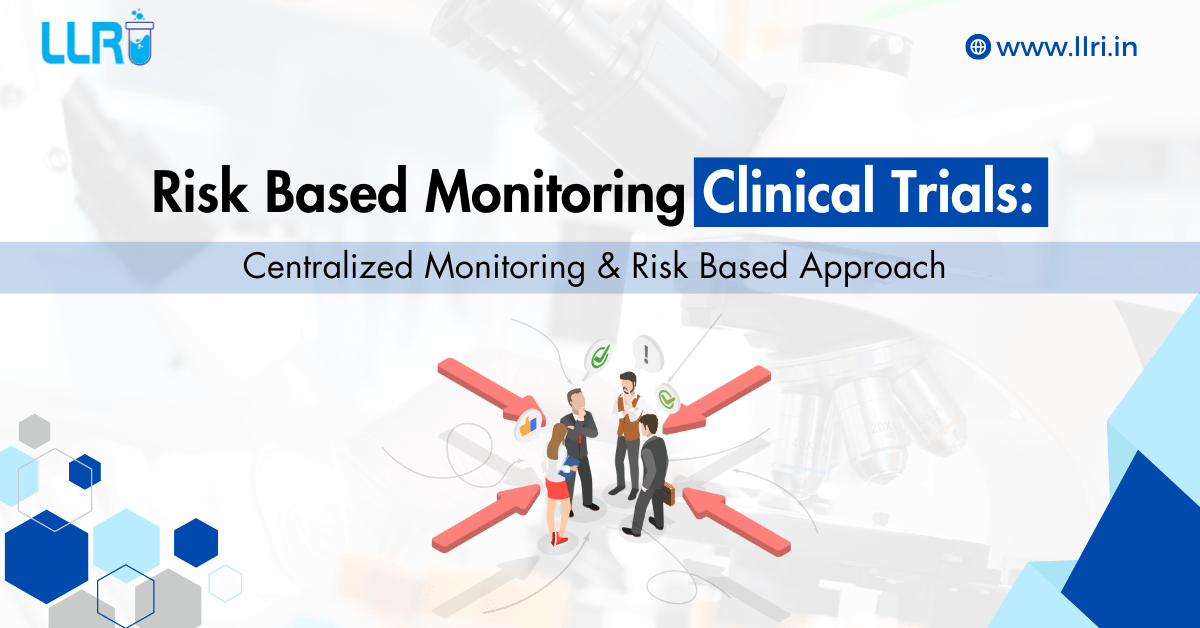Risk Based Monitoring Clinical Trials: Clinical trials are essential for the development of new medical treatments, evaluating the safety and effectiveness of drugs, devices, and therapies for various illnesses and patient populations.
But what makes a clinical trial successful? Does it have to do with the quality of the clinical research institute? Well, honestly yes, but a lot has to do with risk based monitoring in clinical trials. And we will learn about it all here in this blog by LLRI.
This article contains the following:
- Risk Based Monitoring (RBM) Clinical Trials
- RBM In Clinical Trials
- Centralized Monitoring Clinical Trials
- Risk Based Approach Clinical Trials
What Is Risk Based Monitoring Clinical Trials?

Risk Based Monitoring in clinical trials is an innovative approach in the clinical research field that meets regulatory requirements while moving away from the traditional method of 100% source data verification (SDV).
Through the application of various tools, platforms, and dashboards, RBM identifies potential issues related to trial conduct, safety, data integrity, compliance, and enrollment. This targeted approach in the case of risk based monitoring clinical trials, allows the study teams to concentrate on high-value tasks and focus resources on specific trial-related matters.
There’s no ambiguity over the fact that clinical trials are central to the development and delivery of breakthrough medical treatments. They evaluate which drugs, devices, and treatments are safe and effective for humans and determine which therapies work best for specific illnesses or patient populations.
For a clinical trial to be successful, it requires high-quality data, robust patient safety protocols, cost-effectiveness, and speed, states the FDA (Food and Drug Administration), facilitating the whole risk based monitoring clinical trials.
What Are The Benefits Of RBM In Clinical Trials?
- Improved data quality: RBM enhances data quality by identifying, assessing, monitoring, and mitigating risks more effectively.
- Improved patient safety: By focusing on critical data and processes, RBM ensures that patient safety is prioritized.
- Cost-effectiveness: RBM in clinical trials reduces the need for extensive on-site monitoring leads to significant cost savings.
- Efficiency: RBM allows study teams to allocate resources more efficiently, concentrating on areas that require the most attention.
What Are The Steps In RBM Approach?
According to FDA guidance, an RBM approach involves three critical steps:
- Detection of critical data and processes: Identifying the most important data and processes that impact the trial’s success.
- Performing a risk assessment: Evaluating potential risks that could affect trial outcomes and patient safety.
- Developing a monitoring plan: Creating a comprehensive plan that incorporates a risk-based approach to monitoring, focusing on high-risk areas and critical events.

What Is Centralized Monitoring In Clinical Trials?
Centralized monitoring is a key component of RBM in clinical trials. This process involves performing monitoring activities remotely, using technology to oversee the trial’s progress.
By analyzing data centrally, teams can detect outlying, inlying, erroneous, operationally deficient, or potentially fraudulent data. This targeted approach reduces the volume and frequency of on-site visits, focusing monitoring efforts on high-risk sites and critical events identified in the clinical study.
Regulatory Support for RBM In Clinical Trials
Regulatory authorities, including the FDA and EMA, recognize the potential of RBM to enhance clinical trial conduct across all phases. Although RBM is not yet mandated by any regulator, guidance documents encourage sponsors to apply risk-based approaches to study management.
Both the FDA and EMA (European Medicines Agency) accept that less data review is appropriate in lower-risk studies and during lower-risk periods of initially higher-risk studies.
Implementing RBM In Clinical Trials: Steps and Considerations
Implementing RBM involves several key steps outlined by regulatory authorities:
- Detection of critical data and processes: Utilize tools and platforms to identify critical data points and processes that impact trial outcomes.
- Risk assessment: Conduct thorough risk assessments to identify potential vulnerabilities and develop mitigation strategies.
- Monitoring plan development: Create a comprehensive monitoring plan that integrates risk-based methodologies, ensuring efficient allocation of monitoring resources.

On A Final Note…
Risk Based Monitoring clinical trials offer a promising path forward, combining regulatory compliance with innovative monitoring techniques. RBM enhances the quality and efficiency of clinical trials. Regulatory authorities support this approach, recognizing its potential to improve trial conduct and outcomes.
Also, centralized monitoring plays a crucial role in RBM, ensuring data integrity and cost-effectiveness. As the industry continues to evolve, RBM is likely to become an integral part of clinical trial management, offering a more targeted and efficient approach to monitoring.
For more information, visit us here!

